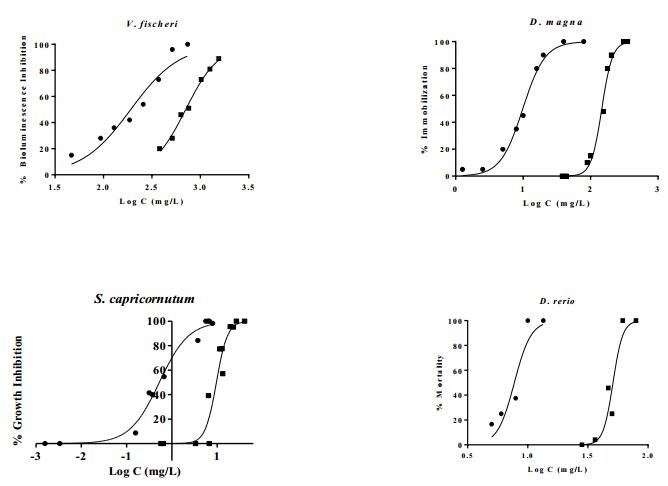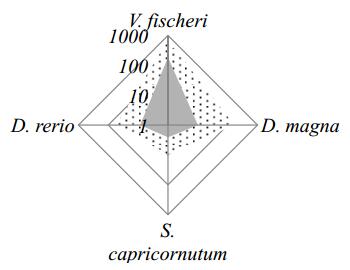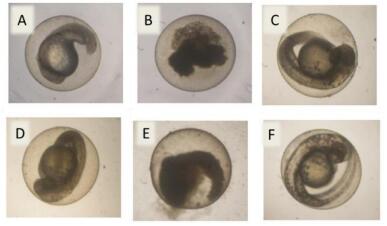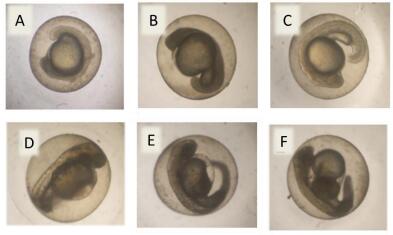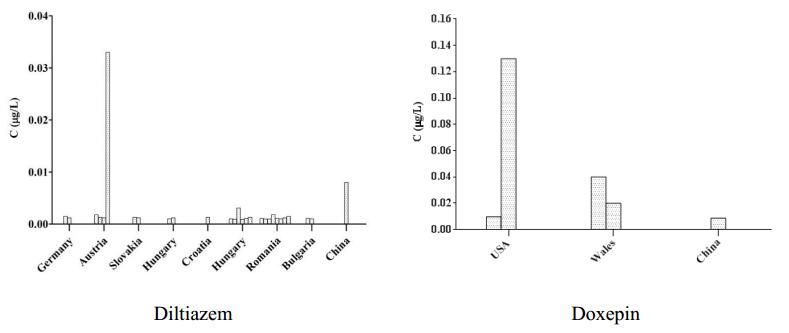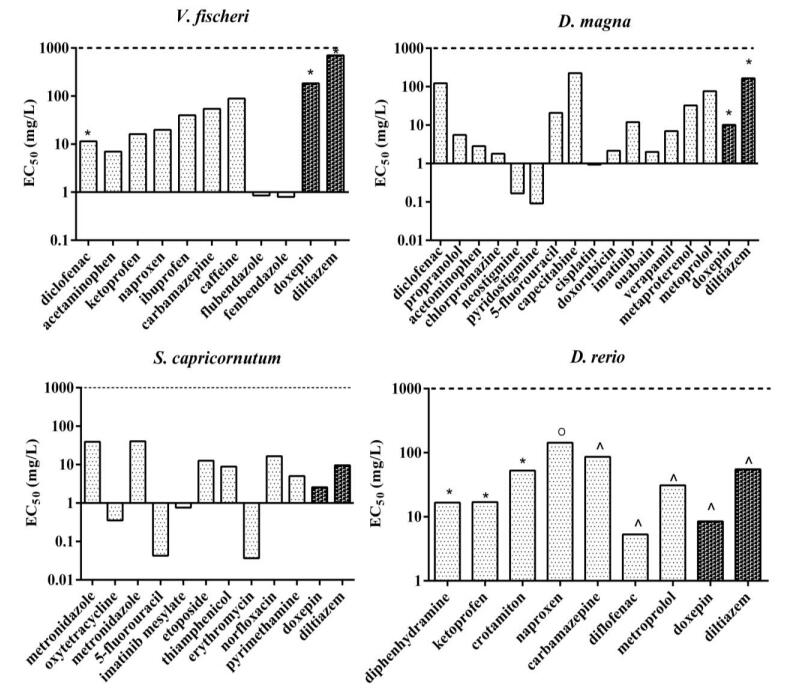1. Introduction
Despite the exceptional benefit of pharmaceuticals for human health, progress and development, in recent years drugs are becoming a serious environmental and public health problem [1]. Currently, greater than 100 human and veterinary drugs have been detected in the environment [2]; the vast majority of detections have occurred in surface waters. The first alarms on this phenomenon of contamination were caused by the increasing presence of antibiotics in the aquatic environment with different degradation processes [3,4]. Since then, numerous studies have been carried out assessing the environmental effect of single pharmaceuticals or mixtures [5,6,7,8]. As a result, it has been documented that most pharmaceuticals, that are designed to interact with a certain target to deliver the desired therapeutic effect, can affect environmental organisms, if these targets are naturally present. Environmental effects can be of different nature, behavioural or histological changes, biochemical responses, or even geno or cytotoxicity at different levels [9].
The presence of pharmaceuticals in the environment is a global phenomenon; there are multiple types of drugs at very different concentrations and in very different body waters. In Figure 1, the occurrence of a selection of drugs in surface waters in the environment worldwide is shown [2,9,10,11,12,13,14,15,16,17,18].
The measured environmental concentration depends on a number of factors such as daily intake in the region, type of sewage treatment and rate of removal in the sewage treatment plants, stream of the final fate flow, biodegradability and/or chemical degradation ability. Measurements of concentrations of drugs in body waters [2,9,10,11,12,13,14,15,16,17,18] indicate that, in most cases, the risk associated to the presence of pharmaceuticals in the environment is low, i.e., in terms of Environmental Risk Assessment approach [19], the measured environmental concentrations are much lower than the predicted concentrations that produce no effect in the environment [20]. However, the prolonged exposure to a cocktail of drugs has not been fully determined and there is still lack of information regarding the environmental effect of pharmaceuticals traditionally present in the environment [21,22]. This is the case of the pharmaceuticals doxepin and diltiazem. Doxepin is a tricyclic antidepressant derived from dibenzoxepine, that blocks the reuptake of noradrenaline and serotonin (5-HT) by the neuronal membrane and increases the concentration of these hormones and therefore, the transmission in the central nervous system. Thus, it is indicated for the treatment of depression, especially in cases of anxiety or insomnia [23]. On the other hand, diltiazem is a calcium channel blocker that inhibits the contractile process of vascular smooth muscle, which results in arteriolar vasodilatation with a reduction of peripheral resistance (afterload). It is used for ischemic heart disease, as antiarrhythmic and it is a general vasodilator (therefore, used for arterial hypertension) [24]. Both drugs have been found in the environment in surface continental waters and in influents of sewage water treatment plants [16,18,25,26]. The maximum concentration of doxepin has been found in Danube river (Klostemeuburg, Austria) with 33 ng/L [17] and for diltiazem it has been 130 ng/L in Lake Erie, USA [17]. Furthermore, diltiazem has been found in several wild species (catfish, largemouth, etc) with concentrations exceeding human therapeutic doses [27].
Considering that the two drugs have been found in the environment, we have carried out this study to analyse the environmental risk and harmful effect of these drugs in the environment. We hypothesized that the environmental concentrations of the pharmaceuticals will be lower than the EC50 affecting well-known biomodels. Thus the environmental risk of doxepin and diltiazem will be low. For this, we have explored the (eco)toxicity of the drugs, observing several acute lethal and sublethal effects, using several biomodels covering the trophic chain (algae, bacteria, crustaceans and fishes) as well as several thermosphysical properties of the studied pharmaceuticals (water solubility, critical aggregation concentration, c.a.c, and octanol water partition coefficient, Log P). These properties provide useful information about the form in which the chemicals will be found in the environment, routes of exposure and potential bioavailability [28,29].
2. Materials and method
2.1. Chemicals
Doxepin hydrochloride (99.3%) and diltiazem hydrochloride (100%) have been provided by Acofarma and Fagron, respectively. The chemical structures and molecular weights of the studied drugs are shown in Table 1. For measuring Log P, n-octanol has been provided by Acofarma and distilled water by the system SIEMENS SG Series Compact.
Table 1. Chemical structure and molecular weight of studied drugs.
|
Chemical structure |
Molecular weight (g/mol) |
CAS number |
| Doxepin hydrochloride |
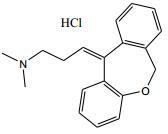 |
316 |
1229-29-4 |
| Diltiazem hydrochloride |
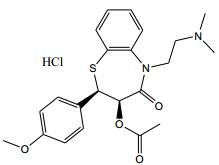 |
451 |
33286-22-5 |
2.2. Ecotoxicological study
Several biomodels were selected for the ecotoxicological evaluaton of diltiazem and doxepine: Vibrio fischeri (V. fischeri), Daphnia magna (D. magna), Selenastrum capricornutum (S. capricornutum) and Danio rerio (D. rerio). All experiments have been performed in compliance with the relevant laws and institutional guidelines, and institutional committee of Universidad San Jorge has approved these experiments. Stock solutions for all the test were prepared using Milli Pore MilliQ water with resistivity of 18.2 MΩ·cm. The mixtures were prepared using a Sartorious semi-micro balance CP225-D with an uncertainty of ±10−5 g. The estimated uncertainty in the concentrations is ±1 × 10−4 g·L−1.
2.2.1. The inhibition of bioluminescence of V. fischeri
The lyophilized V. fischeri (strain NRRL-B-11177) used for the bioluminescence inhibition assays have been obtained from Macharey-Nagel (ref. 945 006). This study has been based on the standard procedure [30]. Bacteria have been rehydrated according to the supplier specifications. The reactivated bacteria have been stored for 5 min in the refrigerator at a temperature between 2–8 ℃. 2% NaCl stock solution has been used as solvent to prepare several dilutions of the studied compounds. The different concentrations ranges for these substances have been between 0–400 mg/L for doxepin, and 0–1200 mg/L for diltiazem. The pH of the solutions has been adjusted to 7–7.5. Additionally, positive controls with phenol, 42.5 mg/L and zinc sulphate, 2.2 mg/L and negative controls have been tested [31]. Next, 0.5 mL of the reactivated bacterial suspension has been transferred to cuvettes. The solution equilibrated for 10 min at 15 ℃, and subsequently, the first measurements have been taken to obtain the initial luminescence; then 0.5 mL of each dilution to be tested has been added to the cuvette. The inhibition of luminescence has been measured after 30 min using a Biofix® Lumi-10 luminometer (Macharey-Nagel), acute mode (Biotox B) values reflect the difference between bacterial light produced by bacteria without toxic compound and that emitted when have been exposed for 30 minutes. The sensitivity is 10 fmol ATP for ATP bioluminescence assays CLS II (Roche Diagnostics GmbH, Mannheim Germany).
2.2.2. D. magna acute immobilization test
The experiment has been carried out in accordance with the OECD 202 test conditions and operating protocol [32,33].
First, the medium for the eggs has been prepared according to the specifications of the supplier. Next, the eggs have been incubated for 72 hours at 20–22 ℃ with 6000 lux in a TOXKIT model CH-0120D-AC/DC incubator (supplied by ECOTEST). When the number of neonates is enough, a vial of spirulina has been added to feed them 2 hours prior to starting the bioassay. Several dilutions for the four studied chemicals have been prepared in aqueous medium solution. In this case, the different concentrations range for these drugs has been between 0–70 mg/L for doxepin and 0–350 mg/L for diltiazem. Additionally, negative and positive controls with K2Cr2O7 (0.6–2.1 mg/L) have been also tested [33]. Furthermore, the pH of the solutions has been adjusted to be between 7–7.5. After 2 hours of feeding, a total of 20 organisms (aged < 24 h) have been used. The organisms have been divided into four groups of five organisms per group. All concentrations with the daphnids have been incubated in complete darkness for 24 hours at 20–22 ℃. The test has been repeated in triplicate. After 24 hours in darkness, the immobilization of the daphnids has been measured. The daphnids that have been unable to swim for 15 seconds after gentle stirring have been considered immobile.
2.2.3. Growth inhibition test with S. capricornutum
The ecotoxicity test with algae is based on the OECD 201 [34]. The species used is S. capricornutum freshwater unicellular algae, immobilized in beads from ECOTEST. The medium has been prepared according the specifications provided from the supplier. The pH is adjusted to 8.1 ± 0.2. After the demobilisation of the algae beads, the inoculum with concentration 106 cells/mL, has been prepared from optical density (OD) at 670 nm (JENWAY 6300 spectrophotometer, 25 mL cuvettes), using the calibration relationship provided by the supplier. Stock solutions of the two drugs have been prepared and serial solutions following geometric progressions have been also prepared. A 96 multiwell plate has been used for the exposition; 7 concentrations and 5 replicas per pharmaceutical. Wells have been inoculated and the final algae cellular concentration in each well has been 104 cells/mL. A multiplate with negative control has been also inoculated. The plates have been incubated for 72 hours with cap at a controlled temperature of 21.5 ± 1 ℃ in a refrigerated incubator with controlled sideway illumination 10,000 lux. OD of the samples at 670 nm has been measured (SPECTRO star Nano, BMG LABTECH, BL-3100) at 24, 48 and 72 h. Only at 72 hours the wells have been resuspended prior to making the final OD measurement. Daily average OD values have been calculated for each drug dilution and negative controls. Finally, the percentage of algal growth inhibition has been calculated at each concentration of toxicant and the resulting EC50 at 72 hours according to the following equation:
Where, Iy is the percentage of growth inhibition for the drug y, YT is the growth rate for concentration y, and Yc is the control growth rate.
2.2.4. Fish embryo acute toxicity with D. rerio
Fish embryo acute toxicity (FET) test in zebrafish has been developed in ZFBiolabs and consisted of an adaptation of FET approved as OECD 236 [35].
Embryos of D. rerio have been obtained by in vitro fecundation and hatchings have been selected when percentage of viability has been over 80%.
A 0.25% DMSO solution has been used to dilute the compounds. DMSO is used to increase the permeability of embryo chorion. The temperature is maintained between 24 and 26 ℃ and oxygen saturation between 60 and 100%. The pH is adjusted to 6.5–8.5 if necessary. For doxepin, concentrations ranged between 5–50 mg/L and for diltiazem 5–500 mg/L. Positive controls consisted of 4-actetaminophen or paracetamol (4155 mg/L). Negative controls have been also included. Twelve embryos have been exposed to each concentration with a dilution factor of 2. Signs of lethality of embryos (coagulation of fertilized eggs, nonformation of somites, lack of detachment of the tail and lack of heart beat at 48 hours) have been observed 24 and 48 hours post exposure (hpe) to the chemicals to determine LC50 at 48 hours. Assays have been repeated at least twice. Embryos were exposed to the toxicants 2 hours post fecundation (hpf).
2.3. Statistics and graphical representation
The null hypothesis is that the ratio obtained dividing EC50 values equals 1; if it significantly differs from 1, null hypothesis was rejected because those values are significantly different (p < 0.05). Obtained results were fitted to obtain the corresponding EC50 values and standard deviations (SD) using the least squares method:
where %I denotes % bioluminescence inhibition for V. fischeri, % immobilization for D. magna, % of growth inhibition for S. capricornutum and % mortality for D. rerio, c is for concentration (in mg/L) in all the cases and a and b are adjustable parameters.
2.4. Physicochemical properties
In this work several physicochemical properties such as solubility, critical aggregation concentration and partition coefficient (n-octanol/water) have been measured.
2.4.1. Solubility
Experimental determination of the solubility, s, in water of studied drugs has been carried out using a turbidimetric method. The solubility has been detected by the appearance of an unclear solution as a consequence of adding accurately determined quantities of the chemical to known quantity of water in the cell, with continuous stirring at 22 ℃ and atmospheric pressure [36]. These quantities have been also checked by mass differences. Solubility values have been determined at least three times and the results have been averaged, to ensure an uncertainty lower than 1%.
2.4.2. Critical aggregation concentration
Critical aggregation concentration corresponds to the concentration at which detectable molecular aggregates are formed. The presence of molecular aggregates in the solution produces structural changes that lead to significant variations in the physicochemical properties. This effect is indicated by an inflection point in plots of the properties of solutions against the concentration. In this case, the value of the c.a.c has been calculated using experimental data of density and conductivity. Details of the experimental procedure can be found elsewhere [29]. Conductivity of the mixtures, used for the calculation of c.a.c, has been determined at room temperature by a conductivity meter JANNA INSTRUMMENTS HI8733. The final uncertainty of conductivity can be estimated in ±1%.
2.4.3. Partition coefficient (n-octanol/water)
Log P has been obtained at room temperature using the shake flask method of the OECD Guideline 107 [37]. A total mass of 20, 10 and 5 mg of each drug have been dissolved in 100, 50 and 25 mL of water respectively. Next, 100, 50 and 25 mL of n-octanol have been added to the mixture water-drug. The separating funnel is stirred for an extended period allowing the equilibrium to be reached. After that, the separation of the two phases has been achieved and the concentration of drugs has been analysed in a UV visible-spectrophotometer: Nano star SPECTRO, BMG LABTECH, BL-3100 model at 257 nm for doxepin and 274 nm in the case of diltiazem. These assays have been determined at three times and the results have been averaged, to ensure the range of ±0.3 units.
3. Results
3.1. Ecotoxicological study
EC50 values for the aquatic bioindicators studied are shown in Table 2. Dose-response curves are graphically represented in Figure 2.
Table 2. Acute EC50 (mg/L) values of aquatic bioindicator for studied drugs. Times of exposure and end point: V. fischeri-30 min-inhibition of bioluminescence, D. magna-24 h-immobilization, S. capricornutum-72 h-growth inhibition, D. rerio-48 h-mortality.
|
V. fischeri |
D. magna |
S. capricornutum |
D. rerio |
| Doxepin |
184 ± 26 |
10.1 ± 1.0 |
0.43 ± 0.25 |
8.0 ± 2.5 |
| Diltiazem |
704 ± 2 |
165 ± 14 |
9.6 ± 1.7 |
51 ± 6 |
The toxicity of both substances may be considered dependent on their concentration; that is, the more concentrated the drug is in the medium, the more toxic the compound is. For all the studied aquatic organisms, diltiazem is the least toxic. Figure 3 shows that the most sensitive bioindicator is algae S. capricornutum followed by D. rerio, D. magna and finally by bacteria V. fischeri for both studied chemicals.
Results obtained for the bioindicator D. rerio, when exposed to doxepin indicates that, at 24 hpf, concentrations of 23 mg/L causes delayed development (Figure 4A). If concentration increases, embryos die (Figure 4B). 48 hpe results indicate that doxepin causes no effect in the embryos if the concentration is lower than 6 mg/L (Figure 4C). Higher concentrations produce sublethal effects on the general state of the embryos, with slow or undetectable blood flow and slow heart beat (Figure 4D) and finally, death at 8 mg/L (Figure 4E).
In the case of diltiazem, at 24 hpf, a concentration of 50 mg/L produces slightly delayed development in the embryos (Figure 5A, embryo with only 18 somites). Higher concentrations of diltiazem produce absence of movement (at 61 mg/L) and finally necrosis (79 mg/L) (Figure 5, images B and C respectively). At 48 hpe, 36 mg/L induces sublethal effects such as heart edema and erythrocyte accumulation in the embryos that are still alive but blood flow is quite slow or undetectable (Figure 5D). If concentration increases, necrosis appears (Figure 5E) and death comes (Figure 5F).
3.2. Physicochemical properties
Several environmental physicochemical properties were experimentally measured and gathered. Values of solubility (s), critical aggregation concentration (c.a.c) and partition coefficient (Log P) are shown in Table 3.
Table 3. Physicochemical properties for studied drugs.
|
s (g/L) |
Log P |
c.a.c (mol/kg) |
| Doxepin |
779.6 |
−0.548 |
0.008 |
| Diltiazem |
477.9 |
0.0135 |
0.086 |
4. Discussion
4.1. Ecotoxicological study
In previous studies, the ecotoxicity of diltiazem was evaluated for other endpoints and results agree with the obtained in this work. For instance, the toxic effect in D. magna has been measured after 48 and 96 hours of exposition [38], with EC50 values of 28 and 8.2 mg/L respectively. The effect of diltiazem in Oryzias latipes has been also assessed showing high toxicity in this fish species too (EC50 = 25.6 and 15 mg/L for 48 and 96 hour of exposure) [38]. Finally, high toxicities of diltiazem have been also found in the bioindicator Dugesia japonica [39]. As far as we know, there is no previous ecotoxicological information for doxepin.
In Figure 6, the environmental concentrations of the drugs studied found worldwide are shown (values have been obtained in different body surface waters and seasonal period). The maximum concentration value of doxepin has been found in Danube river (Klostemeuburg, Austria), 33 ng/L [17] while for diltiazem maximum concentration has been 130 ng/L in Lake Erie (EEUU) [17].
The mean environmental concentration is 2.6 ng/L for doxepin [17] and 41 ng/L for diltiazem [18,40]. Thus, the order of magnitude of the ecotoxicity values for the drugs under study is notably higher than the environmental concentrations found. According to the general procedure of the Environmental Risk Assessment [19], predicted environmental concentrations that ensure low risk are about 1000 times higher than measured environmental concentrations. Consequently, the environmental toxicological risk is quite low for both doxepin and diltiazem.
Taking into account the classification of Passino & Smith [41], diltiazem is a compound practically harmless for the environment with EC50 between 100–1000 mg/L for V. fischeri and D. magna, however in the case of D. rerio it can be considered as slightly toxic and for S.capricornutum, highly toxic (0.1–1 mg/L). On the other hand, doxepin can be classified as slightly toxic with EC50 between 1–10 mg/L, excepting for V. fischeri that can be considered as practically harmless (100–1000 mg/L).
In Figure 7, the EC50 of a number of pharmaceuticals in the four studied bioindicators, including doxepin and diltiazem and making explicit the general limit of toxicity (i.e., EC50 = 1000 mg/L) is shown [42,43,44,45,46,47,48,49]. The measured endpoints for each biomodel are the same as described in the methodology section and times of exposition are shown in the figure for comparing purposes. As it can be deducted from the figure, all the (eco) toxicities of the gathered pharmaceuticals are higher than t toxicity limit. This information shows the potential risk of these emerging pollutants. Once again, algae S. capricornutum seems to be, in general, the most sensitive species while for bacteria V. fisheri, the average toxic effect is lower. In most cases, the EC50 values varied between species. For V. fischeri and D. rerio bioindicators, most of literature EC50 values are between 10 and 100 mg/L, indicating that they can be considered as practically harmless. However, in the case of D. magna and S. capricornutum the EC50 values are more dispersed and ranged between 0.1 and 100 mg/L.
Regarding the comparison of the values obtained for the EC50 for doxepin and diltiazem in this work with previous studies, it is interesting to note, as far as we know, ecotoxicity of doxepin has not been evaluated using either V. fisheri, D. magna, S. capricornutum or D. rerio. In the case of diltiazem, previous results for V. fisheri (at 15 min of exposition), EC50 = 263.7 mg/L and D. magna (at 48 of exposition), EC50 = 28 mg/L were found [38].
4.2. Physicochemical properties
The analysed properties provide quite useful information about the form in which the chemicals will be found in the environment, routes of exposure and potential bioavailability [28]. For instance, solubility is a key environmental parameter since quantify the amount of toxicant dissolve in a body water. Higher solubilities are indicative of an increase in the bioavailability for aquatic organisms that could lead to major toxicity. On the other hand, c.a.c (i.e., the concentration at which small concentrations of molecular aggregates appears) not only offers information about the intermolecular interactions between solute and solvent but also bioavailability.
The study of the aggregation behavior of chemicals has been used effectively in other studies for a better understanding of their toxic effect [50]. In this sense, when the molecules are not aggregated, an increase of the bioavailability in the environment is expected [29]. Finally, partition coefficient of n-octanol and water, Log P (defined as the ratio of the equilibrium concentrations of a dissolved substance in a two-phase system consisting of two largely immiscible solvents) has been traditionally used to estimate the lipophilicity of a toxicant, which is related to their ability to cross through biological membranes and influences their fate after uptake [42].
According to our results, the solubility in water of doxepin is substantially higher than for diltiazem. On the contrary, partition coefficient and c.a.c are higher in diltiazem than in doxepin. In both cases, acute EC50 values found for the four bioindicators are much lower than their corresponding c.a.c. At this point, it should be noticed that although effect concentrations are not measured in the same experimental conditions than c.a.c, and thus, salt concentration should affect (c.a.c is expected to decrease while aggregation number will increase), comparisons can be made, since differences between both values are high. For that reason, for these two drugs, bioavailability at environmental conditions will not be affected by the presence of molecular aggregates.
In this case, solubility become a key property since is directly linked to the accessibility of molecules to reach the organisms and, thus, to produce inhibition or (sub) lethal effects. In this sense, the high value of solubility for doxepin seems to correlate to the (eco) toxicity, and may mean that the bioavailability is higher for aquatic organisms.
5. Conclusion
This work provides an experimental evaluation of doxepin and diltiazem in four aquatic biomodels (V. fischeri, D. magna, S. capricornutum, and D. rerio). Although raw data based only on the calculations of effect and lethal concentrations suggest that diltiazem is less harmful than doxepin, especially in the case of V. fischeri, both drugs can be considered practically harmless for the environment as most of their toxicities are between 100 and 1000 mg/L. It has been demonstrated that the most sensitive biomodel for both drugs is S. capricornutum. This observation has been also found for some other pharmaceuticals. Furthermore, solubility seems to be the key physicochemical property regarding the bioavailability of these two drugs. As a first approximation of the ERA, the environmental toxicological risk of both doxepin and diltiazem is quite low since environmental concentrations found are not significantly high.
Acknowledgments
GREENLIFE (E105) acknowledges financial support from Gobierno de Aragon and Fondo Social Europeo "Construyendo Europa desde Aragon". Furthermore, GREENLIFE acknowledges financial support from Ministerio de Economía y Competitividad (CTQ2013-44867-P) and FEDER. Finally, GREENLIFE thanks EEE53 SL. Business groups: Pinares de Venecia Division Energética and Brial (ENATICA) for support. Both business groups are committed to sustainable developments through environmental respect.
Conflict of interest
All authors declare no conflicts of interest in this paper.









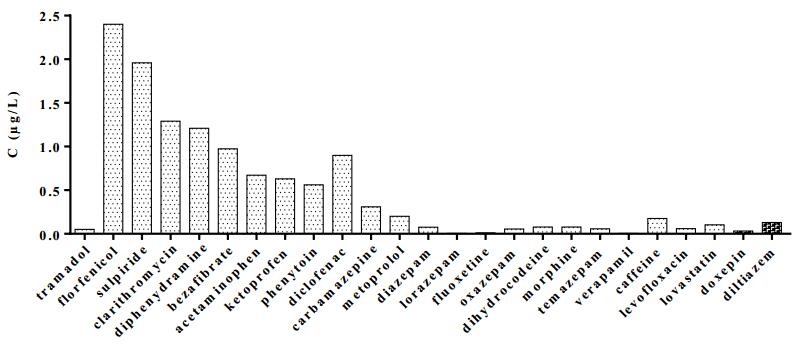
 DownLoad:
DownLoad: 

